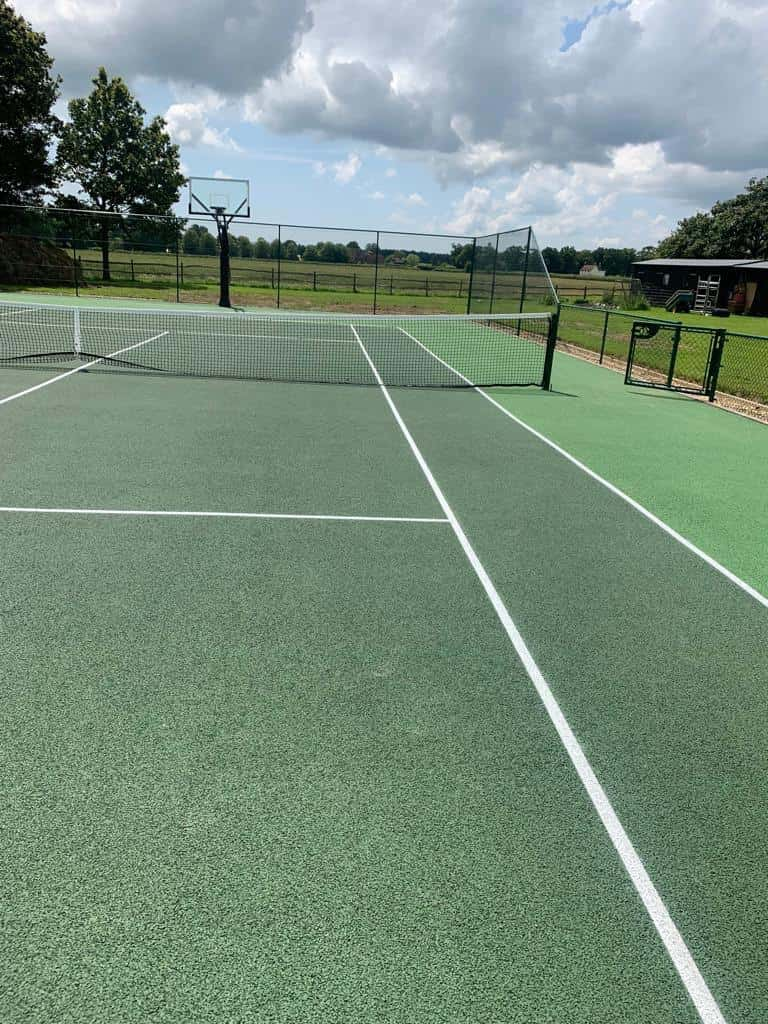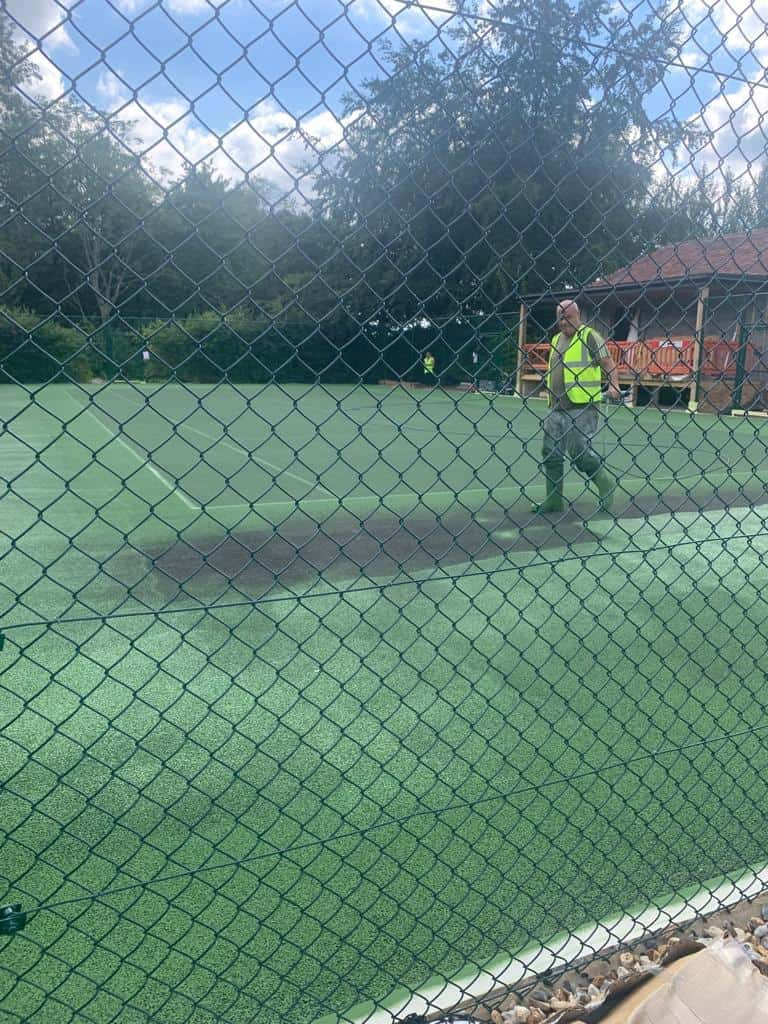A well-maintained tennis court can significantly enhance the playing experience, providing a smooth, even surface that allows for better gameplay and improved safety. Over time, however, even the best courts will show signs of wear and tear, such as cracks, fading, or an uneven surface. When this happens, resurfacing your tennis court can be the perfect solution to restore its appearance and performance. At Tennis Court Construction Kent, we specialise in professional resurfacing services throughout Kent, ensuring your court remains in optimal condition for years to come. In this blog post, we’ll guide you through the key steps and considerations for resurfacing your tennis court, helping you achieve a fresh look and enhanced playability.
1. When Should You Resurface Your Tennis Court?
Understanding when it’s time to resurface your tennis court is the first step in maintaining a high-quality playing surface. Regular use, exposure to the elements, and general ageing can all contribute to the gradual deterioration of your court. Here are some signs that indicate it may be time for a resurfacing:
- Visible Cracks or Fading: Over time, asphalt or concrete courts can develop cracks, which can be caused by changes in temperature or the natural settling of the ground. Fading is also a common issue due to constant exposure to sunlight. If you notice cracks or your court’s colour has significantly faded, resurfacing can restore both its appearance and durability.
- Water Pooling: Poor drainage or an uneven surface can cause water to pool on your court after rain, making it slippery and unsafe for play. Resurfacing can correct these imperfections and ensure proper water runoff.
- Worn Playing Surface: A smooth surface is essential for consistent ball bounce and player comfort. If your court feels rough or has become uneven, resurfacing can help restore the quality of the playing surface.
Resurfacing is a more cost-effective solution compared to a complete court replacement and can extend the life of your tennis court by several years when done correctly.
2. The Resurfacing Process: Step-by-Step
Resurfacing a tennis court requires careful planning and professional execution to achieve a smooth, long-lasting result. Here’s an overview of the steps involved in the resurfacing process:
- Cleaning and Preparing the Surface: The first step is to thoroughly clean the court, removing any debris, dirt, or mould that may have accumulated. Pressure washing is often used to ensure the surface is free from contaminants that could interfere with the new layers.
- Repairing Cracks and Damage: Any cracks, holes, or surface damage must be repaired before applying the new surfacing layers. This may involve filling cracks with specialised materials or patching damaged areas. Proper repairs are essential for preventing future issues and ensuring a smooth finish.
- Applying a New Base Layer: Once repairs are completed, a new base layer is applied. This layer helps to smooth out any remaining imperfections and provides a stable foundation for the topcoat. The base layer also improves the court’s ability to drain water effectively.
- Resurfacing with Acrylic Coating: The next step is applying an acrylic coating, which gives the court its colour and texture. Multiple layers of acrylic surfacing are applied to achieve the desired thickness and durability. This coating not only provides a fresh, vibrant look but also enhances the playing surface by offering the right amount of traction and cushioning.
- Painting Lines and Markings: After the resurfacing is complete, the court’s lines and markings are repainted with precision to ensure accuracy. Properly painted lines are essential for clear gameplay and meeting official standards for court dimensions.
3. Choosing the Right Surface Colour and Texture
The colour and texture of your resurfaced tennis court can have a significant impact on both its appearance and playability. Here’s what to consider when selecting your court’s finish:
- Colour: Traditional tennis court colours include shades of green and blue, but there are other options available to match your aesthetic preferences or to differentiate your court. Lighter colours can make the court appear more spacious, while darker shades can reduce glare during sunny days.
- Texture: The texture of the topcoat affects the speed of play and the level of grip provided by the surface. A slightly rougher texture can provide better traction, which is important for player safety, while a smoother surface may create a faster-paced game. Discussing your preferences with a professional can help you choose the right texture for your court.
At Tennis Court Construction Kent, we offer a range of customisable options, allowing you to achieve the perfect balance of style and functionality for your tennis court.
4. Maintaining Your Resurfaced Court
Once your tennis court has been resurfaced, regular maintenance is key to preserving its fresh appearance and optimal performance. Here are some tips to keep your court in excellent condition:
- Regular Cleaning: Sweep the surface regularly to remove leaves, dirt, and debris. This prevents organic matter from accumulating and breaking down the court’s surface. For more thorough cleaning, a gentle pressure wash can be used.
- Monitor Drainage: Ensure that water drains properly from your court after rainfall. Address any minor pooling immediately to prevent water damage or moss growth.
- Inspect for Damage: Keep an eye out for early signs of wear, such as small cracks or areas where the surface feels uneven. Addressing these issues promptly can prevent them from becoming larger problems.
By following these maintenance practices, you can extend the lifespan of your resurfaced court and ensure it remains a safe and enjoyable space for players.
Conclusion
Resurfacing your tennis court is an effective way to restore its appearance and functionality, providing a smooth, safe, and visually appealing playing surface. Whether you’re dealing with cracks, fading, or simply want to give your court a fresh look, professional resurfacing can make a significant difference. At Tennis Court Construction Kent, we offer expert resurfacing services tailored to the needs of properties in Kent, delivering high-quality results that will keep your court looking and performing at its best.
If you’re considering resurfacing your tennis court or need advice on how to maintain it, contact us today. Our experienced team is here to provide you with a detailed assessment and help you bring new life to your court, ensuring many more years of play. Let us help you achieve a professional-grade court that enhances your property and meets the highest standards of quality.
Call us on: 01580 234 693
Click here to find out more about Tennis Court Construction Kent
Click here to complete our contact form and see how we can help with your court needs.


